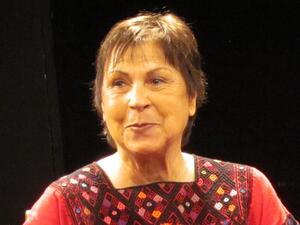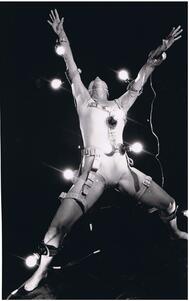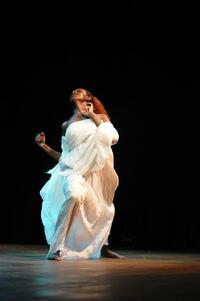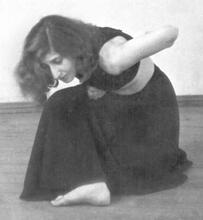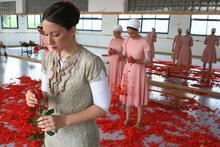Ruth Eshel
Ruth Eshel’s contributions to the development of theatrical dance in Israel span two levels: practice and research. Eshel’s career as an independent dancer and choreographer flourished in the late 1970s and 1980s, as she broke away from the institutionalized dance that flourished in the early days of Israel. Her academic studies led her to write articles and two books Dancing with the Dream: The Development of Artistic Dance in Israel 1920-1964 (1991, Sifriyat Poalim and Dance Library of Israel) and Dance Spreads its Wings: Israeli Concert Dance 1920-2000 (2016, Dance Diaries). She also conducted ethnographic research on Ethiopian Jews in Israel, leading her to form and direct two dance companies: Eskesta Dance Theater (1995-2005) and Beta Dance Troupe (2005-2008), for which she also choreographed.
Family and Education
Ruth Eshel (née Ratner) was born in Haifa, Israel, on May 4, 1942, to Yevgeni (Jenka) Ratner (1909-1979), an Israeli engineer, inventor, and founder of the Israeli Science Force who received the Israel Security Prize, and Shifra Lifshitz (1915-1981), who was a bank teller until her marriage. At the age of four, Ruth began studying dance in Portsmouth, England, when her father enlisted in the Royal Navy Scientific Service. Later she studied with Miriam Bat-Artzi in Haifa, and at the age of ten she began studying ballet with Valentina Arhipova-Grossman and piano at the Donia Weizman Conservatory in Haifa. Upon graduating from the Hebrew Reali School in Haifa in 1960, Eshel continued her piano studies with the composer Haim Alexander at the Jerusalem Academy of Music and Dance, but after a year she gave up the piano and Jerusalem to study dance in Haifa. At the age of eighteen, she served in the Navy.
In 1962 Ruth married Reuven Eshel (b. 1936), the former Vice President of Rafael Research and Development Authority; they have three children: Nurit (b. 1966), Yael (b. 1973), and Ronen (b. 1985).
In 1964 the Eshels traveled to Paris, where Ruth studied with Olga Morozova, a former principal dancer in Ballet Russe de Monte Carlo, recommended by Arhipova-Grossman. She also visited London several times to study with the ballet teacher Phyllis Bedells and passed the Royal Academy of Dance’s (RAD) Elementary and Intermediate examinations in 1964 and 1966. A serious injury in a car accident in Belgium in 1967, which led to the amputation of four toes, unexpectedly altered the course of her career.
After a lengthy period of rehabilitation in Israel, Eshel decided to return to dance but to focus on modern dance. She studied with Rena Gluck, Linda Hodes, Nurit Cohen, Gene Hill-Sagan, Kenneth Gustafason, Lia Schubert, and Kaj Lothmann. In addition, Eshel began teaching modern dance and jazz at the Dance Center in Haifa directed by Schubert and Lothmann and ballet between 1967 and 1969 in the Ga'aton studio under the management of Yehudit Arnon, and in 1971 she prepared students for their final examinations at the RAD’s Israel branch.
Dancer and Choreographer
Eshel's dance career began in Haifa. In 1968, she danced in Oshra Elkayam-Ronen's Dance Company, in 1969 she established the Haifa Chamber Dance Company, and between 1971 and 1975 she danced as a soloist in the Dance Stage company managed by Schubert and Lothmann. In 1976, Eshel danced with the newly formed Batsheva 2 Dance Company, for which she choreographed Dreams (1978), but after one year she left to pave her own independent path in dance.
Dor-Cohen, Eli. Ruth Eshel in Compact Amazona (1986). Directed by Eli Dor-Cohen.
Between 1977 and 1986, a period characterized in Israel by young choreographers breaking away from the institutionalized dance scene towards experimental work, Eshel was a pioneer in dancing solo recitals created for her. Among them were Hedda Oren’s Meditation on Broken Lines (1977), which explores the possibilities of breaking the body’s linear movement, to the sound of Indian music that matches the dancing intervals, Inner and Outer Space (1977), and String (1981); Ronit Land’s People Like Lines (1977), Moto Proprio (1978), and Shoes (1982); and Rachel Cafri’s Image of a Demagogue (1977). Ruth Ziv-Ayal’s The Scarecrow (1977) was characterized by the stillness of the dancer-scarecrow, and in Eli Dor-Cohen’s Compact Amazona (1986), spectators saw dancing light beams emanating from lights attached to Eshel’s body. Eshel and the singer Adi Etzion initiated the avant-grade program Voice and Dance (1978) .The performance at the Israel Museum, Jerusalem, was an intellectual amusment. Etzion sang and improvised in a satiric spirit John Cage’s and Luciano Berio’s music, and Eshel danced a series of kinetic experiments created by Oren, Ziv-Ayal and Eshel herself in an introverted mood.
In 1977, Eshel formed the Ruth Eshel Dance Theater, which was active until 1987. Eshel choreographed and danced the solos Masks (1978), created with Nira Ne’eman; Gown of Stones (1980) and Moments in Time (1986), created with the painter Avraham Ofek. Diapered Branches (1983), created with the sculpture Dalia Meiri, displayed branches and fabrics dancing along the performers, and in the solo Wool and Iron (Myth, 1986), Eshel wallows in a pile of wads of wool while making sounds to the music of Tsippi Fleischer.
Writing and Research
In 1982, while the Eshels were living in California, Ruth completed her Bachelors degree in the humanities from the New College of California. In 1990, she traveled with her husband for a sabbatical in Canada, where she completed her Masters in Theater Studies at the University of Quebec in Montreal. Her thesis dealt with the development of artistic dance in Israel between 1920 and 1948 and its connections to theater. Eshel then shifted her attention to research and wrote her first book, Dancing with the Dream: The Development of Artistic Dance in Israel 1920-1964 (1991, Sifriyat Poalim and Dance Library of Israel). For this project, Eshel collected many artists’ private archives and deposited them in the Dance Library of Israel.
Eshel completed her Ph.D. in Theater at the University of Tel Aviv in 2002, with her dissertation “Movement-Theater in Israel 1976-1991.” Her academic studies opened another creative avenue: criticism and research. Between 1991 and 2017, Eshel wrote reviews for the Haaretz daily newspaper; she lectured in dance history and movement composition courses at the University of Haifa from 1991 to 2005. She also made ten documentary films interviewing key figures in the history of dance in Israel, produced by the Academic Film Channel - University of Haifa, and co-edited, with Giora Manor, Dance in Israel magazine between 1993 and 1998. Since 2000, Eshel has been the founding editor of the Dance Today magazine. She also launched the Israel Dance Diaries website, where Dance Today, Israel Dance, and Israel Dance Annual are published.
From Research to Practice
In 1991 Gila Toledano, then the director of the Dance Library of Israel, invited Eshel to conduct an ethnographic research and documentation of the dance and culture of the Ethiopian Israeli community; the project lasted until 1993. This research took Eshel on another fascinating journey with Ethiopian Jews who immigrated to Israel in two large waves known as Operation Moses (1984) and Operation Solomon (1991). In 1995, four students of Ethiopian origin—Zena Adhenen, Shmuel Bero, Geto Tesfay, and Tesfahon Alamo—came to Eshel’s Movement Composition course at the University of Haifa. They became the basis for Eshel’s new dance company Eskesta Dance Theater. “Eskesta” (“shoulder dance” in Amharic) is the chief characteristic of the Amhara dance, consisting of a variety of shoulder movements. Later the group was joined by seven additional dancers, including Dege Feder, Amen Chula, Godai Betawlin, Sisay Manuab, Avi Gola. Despite being from different backgrounds Eshel and the dancers managed to resolve any cultural differences through dance. The greater Ethiopian community, however, had some difficulties accepting the “new” theatrical Ethiopian dance, but their opposition has softened over time. From that point on, Eshel was passionate about developing a theatrical modern dance style whose sources of inspiration are drawn from Ethiopian folklore.
What the Shoulders Remember. Choreography by Ruth Eshel. Music: Oded Zehavi, Eskesta Dance Troupe. Dancers: Dege Feder, Gilat Bayenne, Gila Bethualin, Amen Chole, Sisay Menua, Avi Gola, 2006.
Interviews by Ruth Eshel with dancer Talia Paz, by Dance in Israel, produced by the Academic Film Channel, University of Haifa.
Interviews by Ruth Eshel with dancer Talia Paz, by Dance in Israel, produced by the Academic Film Channel, University of Haifa.
Eskesta Dance Theater was active at the University of Haifa from 1999 to 2005. After a dispute with the University over a decision by the Dean of the Faculty of Humanities not to allow the company to become professional, Eshel closed the company in 2005 and founded the Beta Dance Troupe at the Neve Yosef Community Center in Haifa, which still operates to this day with Dege Feder as both its artistic director and home choreographer. For Eshel, working within the Ethiopian community was an opportunity to contribute as well as to be enriched by it.
In Esketa and Beta Dance Troupe, Eshel created a unique dance style that combines traditional ethnic Ethiopian movements and gestures with the structure of western modern dance. Among her choreographies for the two companies are Liturgy (1996), Village Memories (1996), Courting (1996), Aspirations (1997), Maharo (1999), Ethiopian Tribal Dances (2000), Love Duet (2000), Opus for Shoulders (2001), Opus for Heads (2002), Nefas (2003), What the Shoulders Remember (2006), Celebration (2007), Tezi-Teza (2008), and In the Heat of Gurage (2009).
In 2013, Eshel won the Israeli Ministry of Culture’s Lifetime Achievement Award in artistic dance, and in 2017 she won the Israeli Artists Association Lifetime Achievement Award.
Eshel continues to surprise us. In 2017 she returned to the limelight, restaging her dance Gown of Stones (1980) and adapting it to her age and span of life. On this occasion, Eshel also announced that she plans to rework her other early works as well.
Selected Works by Ruth Eshel
“Concert Dance in Israel.” Dance Research Journal 35:1 (2003): 61-81.
“Creating in the junction between the authentic and the renewed (Eskesta and Beta Dance groups): a personal story.” Dance Today, 19 (2011): 6-9. (Hebrew)
“A Creative Process in Ethiopian-Israeli Dance: Eskesta Dance Theater and Beta Dance Troupe.” Dance Chronicle, 34:3 (2011): 352-387.
“Dance in Israel – Dance as a Discourse About Change.” Israel Affairs 23:6 (2017): 1003-1023.
Dance Spreads its Wings: Israeli Concert Dance 1920-2000. Dance Diaries, 2016.
Dancing with the Dream: The Development of Artistic Dance in Israel 1920-1964. Tel Aviv: Sifriyat Poalim and Dance Library of Israel, 1991.
“Shoulder Dances: Dance traditions of the Ethiopian Jews.” Israel Dance Quarterly 2 (1993): 68-71.
Dawn, Lille. “Ethiopians in Israel: Their History and Their Dance from Ethnic to Contemporary.” In Seeing Israeli and Jewish Dance, edited by Judith Brin Ingber, 183-197. Detroit: Wayne University Press, 2011.
Golani, Olga. “From head to toe: the amazing story of Ruth Eshel.” Dancelife (December 23, 2009). Accessed December 20, 2019. (Hebrew)
https://www.bizmakebiz.co.il/Members/90e58769-ec63-4c5d-a019-e3d055dc55…
Pulvermacher, Neta. 2018. “A Conversation with Ruth Eshel following her return to the stage at the age of 75, reconstructing her solo ‘Clock of Stone’ (1980) for Between Heaven and Earth Festival.” Dance Today, 33 (2018): 22-25. (Hebrew)
Roginsky, Dina. “The national, the ethnic and in-between: sociological analysis of the interrelations between folk, ethnic and minority dances in Israel.” In Dance Discourse in Israel, edited by Henia Rottenberg and Dina Roginsky, 95-125. Tel Aviv: Resling, 2009. (Hebrew)
Ronen, Dan. “Dance for Everyone: on Multi-Culturalism in Israel and its influence on the Development of Dance.” Dance Today 3 (2000): 85-88.
Toledano, Gila. “Eskesta Dance Theater: artistic dance inspired by Ethiopian folklore” (Hebrew). Dance Today, 3 (2000): 30-35.
Stern, Itay. “After 27 years as a dance critic for Haaretz - Ruth Eshel returns to dance.” Haaretz (October 11, 2017). Accessed January 4, 2020. (Hebrew)
https://www.haaretz.co.il/gallery/dance/.premium-MAGAZINE-1.4499340
Yudelovitch, Meirav. “When the dance spreads wings.” Habama (September 17, 2017). Accessed January 4, 2020. (Hebrew)
http://www.habama.co.il/Pages/Description.aspx?Subj=2&Area=1&ArticleId=…
Videography
Eshel, Ruth. 1981. Diapered Branches (1981), sculptor: Dalia Meiri, dancers: Maya Dunsky, Amalia Rubinstein, Nava Nast and Ruth Eshel. Accessed January 4, 2020.
https://www.youtube.com/watch?v=_s-3xeS9OIU&t=1728s
Eshel, Ruth. 1986. Myth, sculptor: Dalia Meiri, dancer: Ruth Eshel. Accessed January 4, 2020.
https://www.youtube.com/watch?v=mQup-Wzj7HM&t=318s
Eshel, ruth. 1986. “Healing Candle” from Moments in Time, choreography and dance: Ruth Eshel, music: Tzipi Fleischer. Accessed January 4, 2020.
https://www.youtube.com/watch?v=MhI5ctKLW2g&t=222s
Oren, Hedda. 1977. Meditation on a Broken Line (1977). Accessed January 4, 2020.
https://www.youtube.com/watch?v=8EJPLjvBgm0
Videography of interviews by Ruth Eshel: Dance in Israel produced by the Academic Film Channel, University of Haifa
Eshel, Ruth. “Props in Israeli Dance, (Hebrew).” With Rina Schenfeld, Ido Tadmor and Ruth Ziv-Ayal. The Academic Film Chanel, 1999.
Eshel, Ruth. “Gender in Israeli Dance, (Hebrew).” With Nava Zuckerman, Oshra Elkayam-Ronen and Noa Dar. The Academic Chanel, 1999.
Eshel, ruth. “Dance in the Bible, (Hebrew).” With Yardena Cohen and Gila Toledano. The Academic Chanel, 1999.
Eshel, Ruth. “Moshe Efrati and KolDmama, (Hebrew).” With Moshe Efrati. The Academic Chanel, 2000.
Eshel, Ruth. “Choreographer Mirali Sharon, (Hebrew).” With Mirali Sharon. The Academic Chanel, 2001.
Eshel, Ruth. “Dancer and Choreographer Ido Tadmor, (Hebrew).” With Ido Tadmor. The Academic Chanel, July 5, 2010. Chapter one: https://www.youtube.com/watch?v=PByu4wS8oxo. Accessed January 4, 2020.
Eshel, Ruth. “Choreographer Yasmeen Godder, (Hebrew).” With Yasmeen Godder. The Academic Chanel, 2002.
Videography: choreographies for Eskesta Dance Theater and Beta Dance Troupe
Eshel, Ruth. Nefas, Eskesta Dance Theater, 2003. https://www.youtube.com/watch?v=bacUkyzkEeA&t=2s. Accessed January 4, 2020.
Negash, Abdu and Eshel. Ethiopian National Dances, Eskesta Dance Theater, 2000. https://www.youtube.com/watch?v=tFcqt81j740, accessed 4 January, 2020.
Eshel, Ruth. Shoulder Dancing, 2011. https://www.youtube.com/watch?v=JeLsUSbo-Qg&t=119s. Accessed January 4, 2020.
Interviews
Eshel Ruth. “The Beta-Israel Liturgy,” with Margaret Hayun and Ron Atar with the participation of Eskesta Dance Theater. The Academic Channel, 2002.

